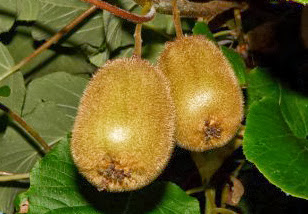A new study that decoded the DNA sequence of the kiwifruit has concluded
that the fruit has many genetic similarities between its 39,040 genes
and other plant species, including potatoes and tomatoes. The study also
has unveiled two major evolutionary events that occurred millions of
years ago in the kiwifruit genome.
published Oct. 18 in Nature Communications.
“The genome sequence will serve as a valuable resource for kiwifruit
research and may facilitate the breeding program for improved fruit
quality and disease resistance,” Fei says.
Kiwifruit originated from the mountains and ranges of southwestern China
and was not really known to the world until the early 20th century,
when farmers in New Zealand discovered the fruit and began breeding it
as a commercial crop. It is a form of berry that grows on woody vines,
much like grapes, and belongs to the order of Ericales, where
blueberries, tea bushes and Brazil nuts are also classified.
One of the most remarkable findings of the study was uncovered when
scientists observed a high percentage of similarities within the
kiwifruit DNA. The data revealed two unusual mishaps that occurred in
the process of cell division about 27 and 80 million years ago, when an
extensive expansion of genes arose from an entire extra copy of the
genome, followed by extensive gene loss.
Fei explains, “The kiwifruit genome has undergone two recent whole-genome duplication events.”
When genes are duplicated, the extra genes can mutate to perform
entirely new functions that were not previously present in the organism.
This process, called neofunctionalization, can occur with no adverse
effects in plants and, in the case of kiwifruit, was quite beneficial.
“The duplication contributed to adding additional members of gene
families that are involved in regulating important kiwifruit
characteristics, such as fruit vitamin C, flavonoid and carotenoid
metabolism,” says Fei.
For the sequencing, the scientists used a Chinese variety called
“Hongyang,” which is widely grown in China, to produce the draft
sequence. They then compared kiwifruit to the genomes of other
representative plant species including tomato, rice, grape and the
mustard weed Arabidopsis. They uncovered about 8,000 genes that were
common among all five species. The comparison revealed important
evolutionary relationships, including the development genes related to
fruit growth, ripening, nutrient metabolism, and disease resistance.
Prior to the study, extensive research on the metabolic accumulation of
vitamin C, carotenoids and flavonoids had been reported in kiwifruits,
but genome sequence data, critical for its breeding and improvement, had
never been available.
“The kiwifruit genome sequence represents the first of a member in the
order Ericales, thus providing a valuable resource for comparative
genomics and evolutionary studies,” Fei says. “We expect to continue
generating genome sequences from other kiwifruit varieties to
investigate the genetic diversity of kiwifruit and elucidate regulatory
networks of important biological processes.”
The sequence is accessible online at the Kiwifruit Genome Database.


No comments:
Post a Comment